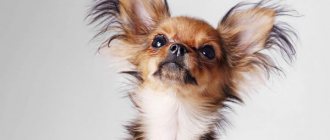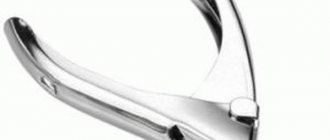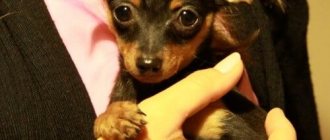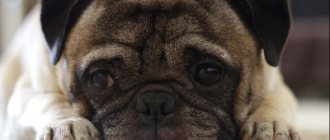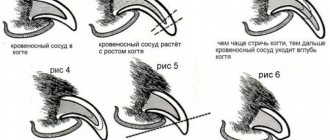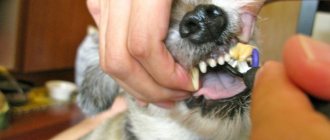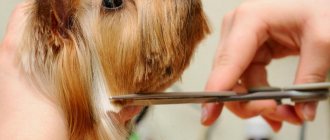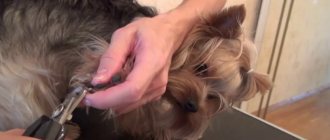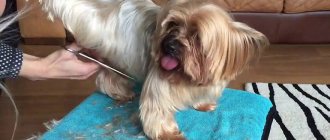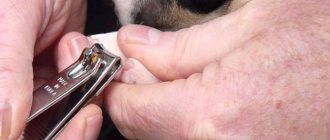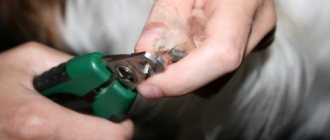Dogs of all breeds and sizes, and even domesticated mongrels, require constant and careful care. The owner must know: what to feed his pet, how to properly take care of the dog’s coat and health, how to trim the dog’s nails with a nail clipper so as not to harm it. And why is this necessary, how often to carry out the procedure at home and the rules for providing first aid in case of injury.
Why are dogs' nails trimmed?
When a puppy appears in the house, he runs around, fools around and can accidentally catch his claw on the tulle or scratch the parquet. To avoid this, puppies' nails are trimmed regularly.
Small dogs' nails grow quickly. It is recommended to cut them once every 14 days. The weight of such pets is small and their claws do not wear off on their own, even on asphalt. If this is not done in time, the claw will become long, hard and can be split when trimmed. The dog will bleed and will need to stop it with a disinfectant.
Smooth-haired dogs' nails are easiest to trim, but long-haired dogs' nails are not so visible. It’s even more difficult if the claw of a long-haired dog is dark. Then it is also necessary to trim the fur between the pads in order to remove the claws without touching the blood vessels.
General information
Of course, very young puppies do not have problems with claws, but from the age of three weeks it is worth keeping an eye on their paws for thin claws that can injure the bitch herself when feeding the puppies, as well as harm the puppy and his littermates in games. .
There are a number of reasons why dogs have their nails trimmed at any age:
- Violation of the structure of the paw: when the claw grows, it does not allow the paw to lie anatomically correctly on the surface when walking, this leads to daily deformation of the paw, which causes pain to the dog.
- Risk of ingrown dogs: yes, this problem is most often typical for adult dogs, but the owner of puppies sometimes needs to monitor how the structure of the pet’s claws is formed, since ingrown claws are sometimes a feature of a particular animal. If you are not sure that you can cope with the discovered ingrown claw, contact a specialist.
- The puppy's delicate and fragile claws can get caught on something and break off. It so happens that kids dig their little beds before bed, play on carpets, and they can simply steal some woven item out of prank, and in the process of playing get caught in the overgrown point of a claw. In such a situation, the baby may simply twitch out of fear that the paw is caught and damage its delicate claw.
Claws that have not yet hardened, but are already sharp, can damage things or scratch you while playing with the puppy. Of course, there is no need to scold the puppy for this, because it is not the baby’s fault that his claws are not treated in a timely manner, because a dog is not a cat, it does not know how to extend its claws and deliberately harm things and people in this way.
All these reasons arise because puppies do not go outside for a long time due to vaccination quarantine, which means they do not have time to grind down their first grown claws.
Anatomy of a dog's claws
There is pulp inside the claw. She's soft. It contains a blood vessel + many nerve endings. On top is the stratum corneum. He's solid.
Together with the claw, the blood vessel grows and lengthens. When the owner does not trim it in time, it will subsequently have to be cut off along with the blood vessel. Part of the pulp is injured. While walking, the dog can infect the wound and become infected with tetanus.
Additional care
Taking care of the health of your paws involves washing them thoroughly after walks. Inspect nails and pads for damage. Treat them regularly with an antiseptic against fungus.
Do not use special detergents too often. Their daily use can cause irritation and dry skin. Detergents are needed only when heavily soiled after active outdoor play.
The dog needs to move and run more so that the nails wear down naturally.
In winter, stuck snow with reagents accumulates between the paw pads. Numerous wounds and cuts are formed. It is recommended to carefully trim the fur between the pads and treat the skin with a protective cream.
It is now fashionable to buy special shoes for decorative breeds. It will protect not only from the cold, but also from damage.
Caring for a dog's nails requires patience and precision. Not only the attractiveness of appearance, but also the health of the pet as a whole depends on regular haircuts. Theoretical knowledge, decisive action and gentle treatment will help carry out the procedure quickly and efficiently.
Share link:
- Click to share on LinkedIn (Opens in new window)
- Click to share on Reddit (Opens in new window)
- Click to share on Pinterest (Opens in new window)
- Click to share on Telegram (Opens in new window)
- Click to share on WhatsApp (Opens in new window)
- Click to share on Skype (Opens in new window)
Tools for trimming claws
- For home use, small or medium nail clippers are often purchased.
- In veterinary clinics, professional tools are large nail clippers.
What tools does a veterinarian use to trim dog nails?
1. Nail clippers or trimmers are special scissors for trimming nails. They are sold in 2 types: in the form of nippers, like scissors, and rounded, sickle-shaped blades. You cannot cut it with simple scissors; they will split the claw.
2. A special file for treating your pet’s claws. The human will not take a strong stratum corneum.
3. Scissors with rounded tips. They are for cutting the fur located between the paw pads. This is the prevention of fungus formation.
4. Guillotine.
5. Machine or trimmer sharpener.
Hair clipper
Instead of the usual tool, you can use a special nail clipper for your dog. The disadvantage of the machine is that it is noisy, so it can scare the animal.
The process of filing sawdust with a machine will take longer; the pet may not be able to sit in one place for a long time. In addition, there is a danger of injuring the pads.
For variety, you can buy a regular nail clipper and a clipper to compare and choose which is better. Nail clippers are professional and compact, battery operated.
Dog nail trimming technology
How the dog should position itself while trimming its claws depends on its size:
- If the pet is small, then it can be comfortably placed on your lap. The body is held with 1 hand, and the other is cut.
- If the dog is large, then make a raised platform, place a rug on it, and place the dog on top. The owner sits down behind him, takes his front paw and carefully holds it behind his back, trimming his claws one by one.
How often should the procedure be performed?
The frequency of nail trimming depends on the conditions in which the dog lives. If your pet lives in the city and walks along the asphalt sidewalk every day, then you will trim its nails less often.
If you live outside the city, you will have to do this more often..
After all, when walking on a soft earthen surface, the claws do not wear down and can grow to serious sizes, and this is fraught with consequences.
Generally speaking, an adult dachshund's nails should be trimmed once every 3-4 weeks..
How can you tell when it's time for a haircut? By the characteristic sound of claws on the floor. As soon as you hear a clattering noise, you know it’s time to trim your nails.
Step-by-step instructions at home
1. The owner takes the pet by the paw and holds it tightly. He holds his hand so that it goes forward and along the paw.
2. The person places his fingers under the paw pad, and with his thumb he holds the finger on which he is going to cut the claw.
3. Before pressing the nail clipper, the owner once again carefully checks whether he has installed it correctly in relation to the claw. There are models where the blade of the nail clipper is not very visible.
4. Carefully cuts off the excess keratinized layer. The vessel of the light-colored claw is clearly visible and the owner will not touch it. In dark ones, you need to cut layer by layer until a point is visible in the center - this is the beginning of the growth of a blood vessel.
5. After trimming each claw, the pet is rewarded with a treat. He will like it and will bear it more calmly.
6. After the first claw, 2 should be trimmed and all in turn. When the dog gets nervous and starts to pull out his paw, you need to let it go. The owner tenderly consoles the dog, scratches it behind the ear, gives it a treat, and soon continues the procedure.
7. When the claws are trimmed, they are properly processed on all sides with an abrasive file. They need to be smooth. After cutting, the edges will be uneven and quite sharp.
Precautionary measures
If injury occurs when shortening the claws, the following steps should be taken:
- Stop the bleeding by sprinkling talcum powder on the wound and pressing it against the affected surface until the bleeding stops completely, even if it takes several minutes. If there is no special product, starch, flour, or a bar of soap will do.
- After this, do not let your pet step on its paw for at least 15-20 minutes. You can keep him in place by offering treats and talking gently, comforting and caressing him. The main thing is to maintain the trust of your friend.
- If the bleeding does not stop within half an hour, you should contact a veterinary clinic.
First aid for injuries
If a claw splits during trimming, most often a vessel will be hit and blood will flow. It needs to be stopped with one of the disinfectants.
Fits:
- hydrogen peroxide (3%);
- blood stopping pencil;
- iodine or potassium permanganate;
- corn starch or baby powder.
When the owner trims the claws, he places cotton pads, peroxide or a styptic pencil nearby on the bedside table or table. If the claw splits, pour a little peroxide onto a cotton pad and apply it to the bleeding wound.
Required Tools
Before trimming and grinding claws, it is important to prepare the tools - sterilize them, treat them with alcohol, an antiseptic solution, or pour boiling water over them.
You will need the following set:
- nail clippers of various modifications;
- files with hard coating;
- hemostatic agents;
- antiseptics.
Ordinary scissors cannot be used, only as an auxiliary material for removing hair that interferes with the inspection of the paws.
For small breeds, miniature individuals, for example, Jack Russell puppies, a nail clipper with a limiter or a guillotine with holes for the nail plates is suitable.
It is better to cut a large dog using special clippers with sharp blades made of steel or brass. They should be treated with chrome on top. Without a protective coating, the tool quickly rusts and deteriorates.
To stop bleeding, use talc or baby powder, or, if they are unavailable, use flour. When treating wounds, use cotton pads or sterile swabs with iodine, peroxide, and potassium permanganate.
It is important to prepare a treat to praise your pet: if he followed the command correctly, wait patiently for the pruning to reward him.
Training to cut hair, praise and reward
It’s good when a dog is trained to trim its nails from puppyhood. An adult can be scared even when his paws are touched by a hand. Do not grab individual fingers or press on the nails.
What to do? At home, calmly take the paw in your hands and stroke it. Give a treat. This stage will take 2 days. Show the dog a nail clipper and get him used to the tool.
The nail clipper is used to touch the paw and the dog receives a treat. 2-3 minutes pass. and repeat everything, securing it with a tasty reward.
Other useful tips
If you trim your dog's nails every two weeks, his keratin layer will increase and the nail bed will recede.
It is much easier to train a puppy to trim their nails than an adult dog. Do not trim the claw blindly. If you couldn’t inspect it, you shouldn’t touch it; you might need to cut its fur first.
If your pet is nervous and easily excitable, you can give him sedative herbal remedies before shortening the nail plates.
When carrying out manipulations with sedatives in veterinary clinics, you can ask the doctor to trim the claws at the same time. Most often, clinic staff in this case agree to do this work without payment.
Do not use alcohol-containing products to stop bleeding in case of injury. This will only increase the pain and cause your pet to panic.
The most unpleasant thing is when a claw is pulled out if the nail cutter is compressed slowly, and the dog pulls out its paw at that moment. In this case, the pet is very painful and scared, as blood vessels and soft tissues are torn. You should immediately contact the clinic after applying ice wrapped in cotton cloth to the wound.
For large breed dogs, it is better to use a pruning shear rather than a guillotine nail clipper.
Briefly about the main thing
- It is best for a dog to undergo the procedure from childhood.
- You can trim your nails at home or in a veterinary clinic.
- Large nail clippers are the easiest way to cut a claw without it splitting, which happens when trimming is done with a small tool.
- At home, you should use a nail clipper and an abrasive file, and always keep a tasty treat on hand.
- In case of an accidental cut, the wound should be treated with hydrogen peroxide or iodine.
- You should accustom your dog to nail clipping through treats.
- The price for a haircut in a veterinary clinic starts from 200 rubles.
Basic Rules
To properly trim your dog's nails, follow these rules::
- Even if your pet walks on asphalt every day, nail trimming is still necessary, especially if the dog has an accessory digit.
- Don’t skimp on a nail clipper; choose not only the most expensive, but also the most convenient device. The main criterion is a comfortable handle and a sharp blade.
- If you do not have experience, do not try to trim your dog’s nails in one go, spread out the procedure over several passes.
- The best time to trim your dog's nails is after bathing. Warm water will relax your pet, and the claws will be easier to cut.
- If hair interferes with trimming nails, be sure to trim it. Otherwise, you will not see what you are doing, which means there will be a risk of injury to the dog.
If you do not have experience, it is better to carry out the first procedure in a salon . An experienced specialist will not only show you how to trim your nails correctly, but will also give you the necessary recommendations.

